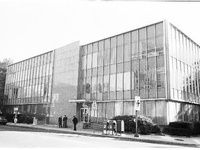The estimate was derived from an architect’s rough and ready “cartoon” drawing of the proposed new center that was sent out to potential donors along with the estimated $30 million figure in an effort to jump-start donations.
More important, Zewinski says, that figure failed to include the cost of renovating Coolidge Hall—which architects later said would have cost 80 percent as much as constructing a new building.
“It was not a budget,” he says. “There was a lot of shadowboxing on this. That was really an administrator trying to start the project.”
Since the initial plan, the University completely rethought CGIS—twice.
First, the project architect concluded renovating Coolige Hall, a former hotel with low ceilings and outdated elevators, would be nearly as expensive as constructing a new building. Besides, Cambridge residents were strongly set against the University eating up the little remaining park area behind Gund Hall.
Multimedia
So in October 1998, the University unveiled a new plan. Coolidge Hall would be razed, along with another Harvard building across the street that houses University Information Systems. In their place, two major new buildings—connected by a costly tunnel under Cambridge Street—would form the heart of CGIS. Four historic houses nearby would be renovated for use as Harvard research centers, and one of them the University had to buy and would have to relocate several blocks away at a cost of about $1 million.
After Cambridge residents blasted the buildings’ appearances at a series of community meetings, the University sent the architect back to the drawing board and, within 60 hours, returned with a completely redesigned plan, replacing the boxy facades with sweeping arcs of glass windows. Harvard also agreed to reduce the buildings’ height and set them farther back from the street.
New construction in the tight spaces close to campus is more expensive, Zewinski says, because more must be built underground—including the tunnel under Cambridge Street and a loading dock.
“Sites are so few and far between that when you get an opportunity like CGIS represents…you’re willing to pay a premium for that,” he says.
But this premium is incredibly high.
The shifts and redesigns raised the cost of CGIS to over $100 million. For nearly a decade now, Dean of the Faculty Jeremy R. Knowles has wanted a government and international studies center to be one of his major projects as dean.
But Zewinski says Knowles stayed strict on the budget question.
For Knowles, signing off on the more ambitious and expensive CGIS meant the Faculty will have to borrow more money for the project and pay interest on the debt out of unrestricted Faculty funds.
“[It is] a sign of the Dean’s commitment,” says John Gerry, assistant dean of the Faculty.
The Name Game
Read more in News
Law School To Produce ‘The Crucible’













